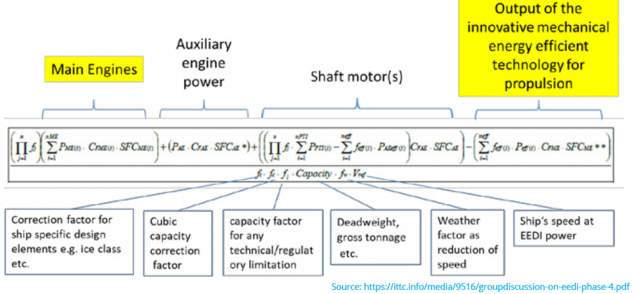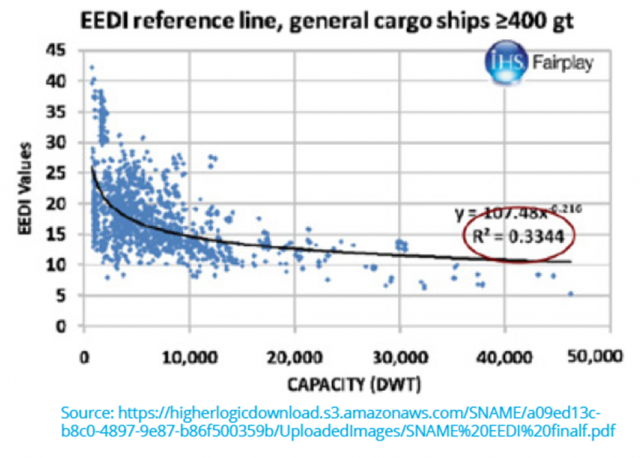Decarbonization and reduction of emission to air is becom-ing a major topic in the shipping business in the upcoming years. Already in the year 1997, the IMO was encouraged by the Kyoto Protocol to work out strategies on a reduction of greenhouse gas emissions from ships.
The climate measure so far agreed at IMO level is the 2011 agreed Energy Efficiency Design Index (EEDI), which is the first regulation to establish CO2 standards in shipping. These amendments are adding new Chapter 4 to MARPOL Annex VI that focuses on the energy efficiency.
The EEDI has to be calculated for newbuildings or existing ships, which has undergone a major conversion and rep-resents the amount of CO2 generated by a ship per ton-mile of goods transported relative to a reference average of similar ships.
Below EEDI formula shows the complexity of the main terms relevant for the calculation.




In 2015, the Paris Agreement has been agreed with the cen-tral aim to strengthen the global response to the threat of climate change. The main goal is to limit the temperature rise well below 2 degrees Celsius compared to pre-indus-trial levels and to take up efforts to limit the temperature increase even further to 1.5 degrees Celsius.
Consequently, the IMO was enforced to establish proce-dures on the reduction of greenhouse gas emissions (GHG) in international shipping.
After several attempts the IMO finally agreed in 2016 at MEPC 70 on a 7-year GHG work program to discuss and agree on measures to address shipping’s climate impact.
One item adopted is the collection and submission of fuel oil consumption data on board of vessels > 5000 GT to their Flag State for aggregation and then submission to IMO man-datory (IMO DCS) starting from 2019 on.
In April 2018, the IMO adopted the initial IMO Strategy on Reduction of GHG emissions from ships and sets quantified GHC reduction targets. General goal is to reduce GHC emissions by improving vessels energy efficiency as well as introducing new technologies and low or zero-carbon fuels.
Up to 2021 following measures are in place: • Since 2013 the Energy Efficiency Design Index (EEDI) for newbuilding’s mandating up to 30% or more improve-ment in design performance depending on ship type and size is in force • The Ship Energy Efficiency Management Plan (SEEMP) for all ships above 400 GT in operation – although it con-tains no explicit and mandatory requirements to con-tent and implementation • Since 2019 the Fuel Oil Consumption Data Collection System (IMO DCS) mandating annual reporting of CO2 emissions for all ships above 5,000 GT During MEPC 76 in June 2021, the IMO adopted amend-ments to MARPOL Annex VI to establish a combination of technical and operational measures, which are meant to be set into force by 2023 and shall be explained in more detail.

EEXI (Energy Efficiency Existing Ship Index)
The EEXI is a technical measure, looking at the design of the ship. It is the retroactive application of the EEDI to all existing ships and is applicable for all vessels above 400 GT. This will impose a requirement to all existing ships regardless of year build and is intended as a one-off certification. The EEXI must be verified by the Class on behalf of the Flag State and a new International Energy Efficiency Certificate will be issued.


Attained EEXI ≤ Required EEXI
In case the attained EEXI is higher compared to the required EEXI ship owners need to decide how to comply.
Possible options are:
- Engine Power Limitation
- Fuel Change
- Energy saving devices
- Retrofitting
- Etc
For verification of the attained EEXI an EEXI Technical File must be prepared and finally confirmed. A new Internation-al Energy Efficiency Certificate (IEEC) has to be issued.

In case vessels do not have the necessary attained EEXI Briese Shipping will take the option of ‘Engine Power Limi-tation’. Consequently, every single vessel, where adjust-ments will be needed, will be verified, adjustment done on board and an Engine Power Limitation (EPL) Manage-ment Plan has to be prepared.
While the EEXI is a one-time certification targeting design pa-rameters, the CII addresses the actual emissions in operation.

The CII is the operational measure considering the actual consumption and distance travelled for each individual ship in service. It measures how efficiently a ship transports goods and is given in grams of CO2 emitted per cargo-carry-ing capacity and nautical mile.
From 2023, a ship must calculate the attained CII based on the IMO DCS data, which are sent via BERT or another tool from board. Adjustment to the tool will be done in 2022.
After 2023 all IMO DCS data will be accumulated and a final attained CII for the year 2023 will be calculated and needs to be verified.
This attained CII must be set in comparison to a required an-nual operational CII. This required CII is based on parame-ters for specific ships which have been generated from IMO DCS data out of 2019.
After verification of the attained CII the ship is given an an-nual rating ranging from A to E whereby the rating limits will be reduced towards 2030.

Based on the IMO DCS data from 2020 following example of the attained and required CII’s for one Briese vessel can be given:

Enhanced Ship Energy Efficiency Management Plan (SEEMP Part III) Consequently, with the launch of the CII rating the SEEMP Part II must be expanded and a so called enhanced SEEMP (SEEMP Part III) for vessels > 5000 GT needs to be developed.
The SEEMP Part III will be prepared by the office and shall include following information:
- Details about the calculation of the ship’s attained CII and the process that will be used to report the infor-mation to the ship’s Administration
- The ship specific required annual operational CII for the next 3 years must be listed in the enhanced SEEMP An implementation plan showing how the required annu-al operational CII shall be achieved during the next three years and which steps will be taken in case a vessel has a D-E rating for three years in a row shall be presented in the SEEMP Part III.
To achieve a C-rating a close communication between char-terer, vessel and owner is needed. Presently the most im-portant factor to reach this rating the vessels speed must be adopted. Further means to improve are:
- Hull condition washing
- Trim
- Routing
Fit for 55 – EU climate package In addition to the above IMO regulations the EU published a ‘Fit for 55’ climate package in July 2021. This package in-cludes a couple of measures for the shipping sector:
- EU ETS – Emission Trading Scheme (ETS) The EU Emission Trading Scheme is one of the main pro-posals meaning the integration of shipping into an open ETS system (trading with other sectors). Included are ves-sels above 5000 GT which fall under the EU MRV Regula-tion. In practice, shipping companies will have to purchase and surrender ETS emission allowances for each ton of re-ported CO2 emissions.
Consequently, the EU MRV will be revised taking the new provisions for monitoring, reporting and verification of emission at company level into account, which means that the reporting tool ‘Bert’ or similar must be adjusted in the next years. Nevertheless, the EU MRV remains a separate regulation.
Shipping companies shall be liable to surrender allowances according to the following schedule:
- 20 % of verified emissions reported for 2023
- 45 % of verified emissions reported for 2024
- 70 % of verified emissions reported for 2025
- 100 % of verified emissions reported for 2026 and each year thereafter Main responsibility for the emission trading is the shipping company responsible for EU MRV.
- FuelEU Maritime This regulation sets up a fuel standard for ships taking the carbon concentration intensity of fuel used in 2020 as a baseline. The yearly average greenhouse gas intensity of the energy used on-board by a ship during a reporting pe-riod shall not exceed the following limits:
- 2 % by 2025
- 6 % by 2030
- 13 % by 2035 In addition, from 1 January 2030, container and passenger ships at berth in an EU port shall connect to on-shore power supply and use it for all energy needs while at berth. OPS (on-shore power supply) exemptions are only possible until the end of 2034.
For implementation of this regulation a monitoring plan has to be submitted in 2024 and a new separate and additional MRV system for the purpose of the FuelEU Maritime will be set up and will apply from 1 January 2025. Based on this data a FuelEU certificate of compliance will be issued. Companies will be also allowed to pool performances of different ships and use the possible over-performance of one ship to com-pensate for the under-performance of another ship.
The geographical scope covering EU ETS and the FuelEU Maritime proposals are at berth, intra-EU voyages and part of the international voyages as reported under the EU MRV, i.e. 50% of inbound and 50% of outbound voyages.
Taking into account the IMO and EU measures in respect of decarbonization in the shipping sector all can see that the next upcoming years will be a huge challenge.
Another influence will be applied by charterers, customers, and stakeholders.